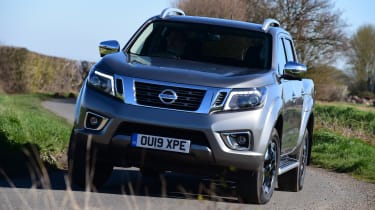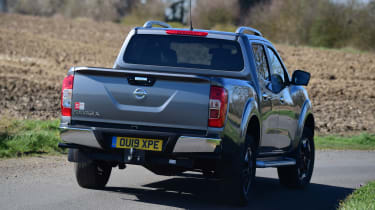Nissan Navara pickup - Engines, drive & performance
More sophisticated rear suspension on the Nissan Navara Double Cab model is transformative
There is only one 2.3-litre diesel engine available for the Nissan NP300 Navara, but it comes in two different forms. Entry-level models get the single-turbo 158bhp version, while those higher up the range come with a more powerful 187bhp twin-turbocharged version of the same engine.
In terms of ride and handling, which bodystyle you go for no longer makes a huge difference. While the King Cab model used to come with more basic leaf-spring suspension, and didn’t ride or handle anywhere near as well as the Double Cab, they now share the same more advanced multi-link setup.
Admittedly, how much fun a pickup truck is to drive is largely an irrelevance. Historically, however, they’ve been underwhelming from behind the wheel, but the new Navara is an improvement in this regard. It stays planted and body lean is well controlled in corners. Granted, the steering is still quite vague and it's nowhere near as accomplished as Nissan's road cars, but in comparison to its pickup rivals, it offers an excellent drive, even if the Ford Ranger is even better.
Ride comfort is superb, too. Most pickups are bouncy and hard-riding due to their utilitarian leaf-spring suspension, but the NP300 Navara Double Cab’s car-like setup means it’s very well controlled and even reasonably comfortable.
Nissan Navara diesel engines
You can choose from two versions of the same 2.3-litre diesel engine. Both the 158 and 187bhp versions are fairly impressive. They're relatively quiet and refined, and at a steady motorway cruise, the dominant noise comes from the wind rushing over the large door mirrors. There's some engine noise at low revs, however.
There’s plenty of power across the rev range, so the Navara is easy to drive, but a two-tonne weight means performance is inevitably rather sluggish. Even the more powerful version takes 11.2 seconds to do 0-62mph – regardless of whether you choose the manual or automatic gearbox. In the less powerful 158bhp model, this jumps to 12.5 seconds, but the Navara feels like it takes its time to do this. The Volkswagen Amarok is faster thanks to its V6 diesel, with every version getting from 0-62mph in under 10 seconds.
Although your choice of gearbox doesn’t affect performance on paper, the automatic does feel much more sluggish than the manual. It’s slower to respond to acceleration – especially when pulling out of junctions – so overtaking can feel quite risky. That said, in normal driving conditions, it’s a very smooth and refined transmission, swapping gears quickly and gently.
The manual feels livelier, especially after an update to its design in 2019. This gave the gearbox longer ratios and a shorter shifting action, which not only improves CO2 emissions, but also means the gearshift feels better and you have to change gear less often.
A selectable all-wheel-drive system with low-range mode and an electronic limited-slip differential should give the Navara more than enough off-road ability for most. It’s the same setup used in the previous Navara, but the addition of that differential, plus hill-descent control and hill-start assistance, has beefed up its capabilities.














